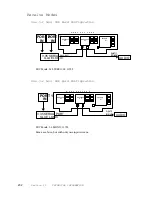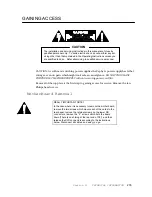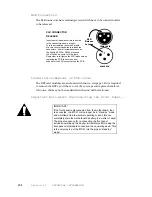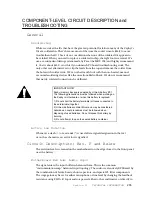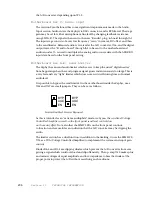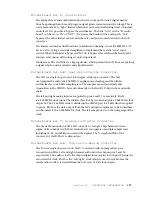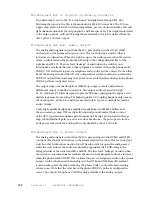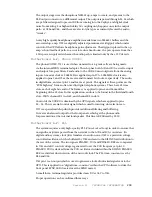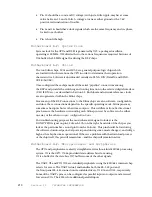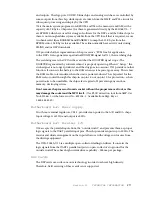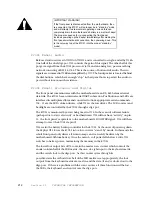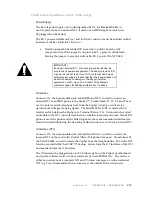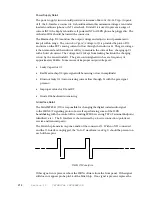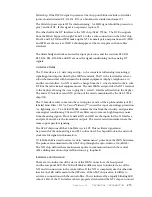
Section 11 TECHNICAL INFORMATION
216
the central office, the LED will blink slowly (about 1 Hz). The LED will come on solid
when the NT1 chip makes a successful connection with the Mitel S Chip, and the
appropriate handshaking is completed.
The front panel will indicate the status of the connection as well. If no cables are
attached, or the card is completely unable to activate a connection with an NT1
(internal or external) the ISDN message will remain at INACT indefinitely. Once the
Mitel chip makes contact with an NT1, the ISDN message will read INIT.
This message will stay on the screen until all appropriate handshaking and protocol
exchange is complete with the central office (i.e. the C.O. recognizes the Zephyr as a
piece of terminal equipment with the appropriate software and then assigns a network
address). When this stage is finished, and the Zephyr is ready to make (or answer) a call,
the READY message will be displayed. At this point, it is probable that the ISDN card is
working properly, and the correct ISDN software is running in the Zephyr.
ISDN S Only Interface Card (Non-USA)
This card is required in parts of the world where the telephone authority provides the
NT1 interface unit.
It’s circuitry is a sub- set of the S/U version, as there is no power supply or NT1
capability.
V.35/X.21 Interface Module
The V.35/X.21 interface card has two independent sections for buffering input
and output of the balanced digital I/O streams. Additionally, a UART offers the
possibility to operate terminal adapters which require RS- 232 serial control.
U2,3 are RS232 driver and receiver chips. They have internal “charge- pump” circuitry to
generate the required plus and minus voltages from the 5 Vdc input
as called- for in the RS- 232 specification (the spec. says between 3 and 12 Volts – these
chips generate 9 Vdc).
U6,7 are balanced drivers for the V.35/X.21. U4,5 are quadruple balanced receivers.
The jumper J1 selects which interrupt line is pulsed from the UART when it needs to
signal to the CPU.
This should always be in the INT1 position.
AES/EBU Interface Card
The AES/EBU card is a plug in expansion for Zephyrs with motherboards of Rev. F or
later. The card allows the Zephyr to use the standard AES/EBU digital audio interface
(provided on many pieces of studio equipment - DAT and CD players are two
examples). The card accepts digital input and provides digital audio output, both of
which can be synched to a variety of sources. Sampling rates of 32kHz, 44.1kHz, and
48kHz are available on both the input and output sides. The physical interface is
provided via the DB- 9 connector on the card edge as well as the second set of XLR
connectors on the Zephyr back panel. AES/EBU card functionality is accessed through
the LCD user interface, and through the RS232 serial interface.
Summary of Contents for Zephyr
Page 13: ...Table of Contents 13 SECTION 1 QUICK RESULTS ...
Page 26: ...Section 2 INTRODUCTION 26 This page intentially left blank ...
Page 27: ...Section 2 INTRODUCTION 27 SECTION 2 INTRODUCTION ...
Page 38: ...Section 2 INTRODUCTION 38 This page intentionally left blank ...
Page 39: ...39 SECTION 3 ZEPHYR AT A GLANCE ...
Page 52: ...Section 4 INSTALLATION BASIC OPERATION 52 This page intentionally left blank ...
Page 53: ...Section 4 INSTALLATION BASIC OP 53 SECTION 4 INSTALLATION BASIC OPERATION ...
Page 84: ...Section 4 INSTALLATION BASIC OPERATION 84 ...
Page 85: ...Section 5 ISDN 85 SECTION 5 ISDN ...
Page 105: ...Section 6 NON ISDN NETWORKS 105 SECTION 7 AUDIO CODING ...
Page 118: ...Section 7 AUDIO CODING PRINCIPLES 118 This page intentionally left blank ...
Page 119: ...Section 8 DETAILED MENU REFERENCE 119 SECTION 8 DETAILED MENU REFERENCE ...
Page 157: ...Section 9 REMOTE CONTROL 157 SECTION 9 REMOTE CONTROL ...
Page 176: ...Section 9 REMOTE CONTROL 176 This page intentionally left blank ...
Page 177: ...Section 10 ADVANCED PROBLEM SOLVING 177 SECTION 10 ADVANCED PROBLEM SOLVING ...
Page 196: ...Section 10 ADVANCED PROBLEM SOLVING 196 This page intentionally left blank ...
Page 197: ...Section 11 TECHNICAL INFORMATION 197 SECTION 11 DETAILED TECHNICAL INFORMATION ...
Page 219: ...Section 12 SCHEMATICS 219 SECTION 12 SCHEMATICS ...
Page 221: ...Section 13 MANUFACTURER S DATA SHEETS 221 SECTION 13 MANUFACTURER S DATA SHEETS ...
Page 223: ...Section 14 SPECIFICATIONS WARRANTY 223 SECTION 14 SPECIFICATIONS AND WARRANTY ...
Page 228: ...228 This page intentionally left blank ...
Page 229: ...Section 15 APPENDICES 229 SECTION 15 APPENDICES ...

